- Home
- Jeffery Deaver
Roadside Crosses: A Kathryn Dance Novel Page 4
Roadside Crosses: A Kathryn Dance Novel Read online
Page 4
“How long are you going to be in the hospital?”
“I’m getting out today, probably. Maybe tomorrow, they said.”
“How’re the doctors? Cute?”
A laugh.
“Where do you go to school?”
“Robert Louis Stevenson.”
“Senior?”
“Yeah, in the fall.”
To put the girl at ease, Dance made small talk: asking about whether she was in summer school, if she’d thought about what college she wanted to attend, her family, sports. “You have any vacation plans?”
“We do now,” she said. “After this. My mom and sister and me are going to visit my grandmother in Florida next week.” There was exasperation in her voice and Dance could tell that the last thing the girl wanted to do was go to Florida with the family.
“Tammy, you can imagine, we really want to find whoever did this to you.”
“Asshole.”
Dance lifted an agreeing eyebrow. “Tell me what happened.”
Tammy explained about being at a club and leaving just after midnight. She was in the parking lot when somebody came up from behind, taped her mouth, hands and feet, threw her in the trunk and then drove to the beach.
“He just left me there to, like, drown.” The girl’s eyes were hollow. Dance, empathetic by nature—a gift from her mother—could feel the horror herself, a hurting tickle down her spine.
“Did you know the attacker?”
The girl shook her head. “But I know what happened.”
“What’s that?”
“Gangs.”
“He was in a gang?”
“Yeah, everybody knows about it. To get into a gang, you have to kill somebody. And if you’re in a Latino gang you have to kill a white girl. Those’re the rules.”
“You think the perp was Latino?”
“Yeah, I’m sure he was. I didn’t see his face but got a look at his hand. It was darker, you know. Not black. But he definitely wasn’t a white guy.”
“How big was he?”
“Not tall. About five-six. But really, really strong. Oh, something else. I think last night I said it was just one guy. But I remembered this morning. There were two of them.”
“You saw two of them?”
“More, I could feel somebody else nearby, you know how that happens?”
“Could it have been a woman?”
“Oh, yeah, maybe. I don’t know. Like I was saying, I was pretty freaked out.”
“Did anybody touch you?”
“No, not that way. Just to put tape on me and throw me in the trunk.” Her eyes flashed with anger.
“Do you remember anything about the drive?”
“No, I was too scared. I think I heard some clanks or something, some noise from inside the car.”
“Not the trunk?”
“No. Like metal or something, I thought. He put it in the car after he got me in the trunk. I saw this movie, one of the Saw movies. And I thought maybe he was going to use whatever it was to torture me.”
The bike, Dance was thinking, recalling the tread marks at the beach. He’d brought a bicycle with him for his escape. She suggested this, but Tammy said that wasn’t it; there was no way to get a bike in the backseat. She added gravely, “And it didn’t sound like a bike.”
“Okay, Tammy.” Dance adjusted her glasses and kept looking at the girl, who glanced at the flowers and cards and stuffed animals. The girl added, “Look at everything people gave me. That bear there, isn’t he the best?”
“He’s cute, yep. . . . So you’re thinking it was some Latino kids in a gang.”
“Yeah. But . . . well, you know, like now, it’s kind of over with.”
“Over with?”
“I mean, I didn’t get killed. Just a little wet.” A laugh as she avoided Dance’s eyes. “They’re definitely freaking. It’s all over the news. I’ll bet they’re gone. I mean, maybe even left town.”
It was certainly true that gangs had initiation rites. And some involved murder. But killings were rarely outside the race or ethnicity of the gang and were most often directed at rival gang members or informants. Besides, what had happened to Tammy was too elaborate. Dance knew from running gang crimes that they were business first; time is money and the less spent on extracurricular activities the better.
Dance had already decided that Tammy didn’t think her attacker was a Latino gangbanger at all. Nor did she believe there were two of them.
In fact, Tammy knew more about the perp than she was letting on.
It was time to get to the truth.
The process of kinesic analysis in interviewing and interrogation is first to establish a baseline—a catalog of behaviors that subjects exhibit when telling the truth: Where do they put their hands, where do they look and how often, do they swallow or clear their throats often, do they lace their speech with “Uhm,” do they tap their feet, do they slouch or sit forward, do they hesitate before answering?
Once the truthful baseline is determined, the kinesic expert will note any deviations from it when the subject is asked questions to which he or she might have reason to answer falsely. When most people lie, they feel stress and anxiety and try to relieve those unpleasant sensations with gestures or speech patterns that differ from the baseline. One of Dance’s favorite quotes came from a man who predated the coining of the term “kinesics” by a hundred years: Charles Darwin, who said, “Repressed emotion almost always comes to the surface in some form of body motion.”
When the subject of the attacker’s identity had arisen, Dance observed that the girl’s body language changed from her baseline: She shifted her hips uneasily and a foot bobbed. Arms and hands are fairly easy for liars to control but we’re much less aware of the rest of our body, especially toes and feet.
Dance also noted other changes: in the pitch of the girl’s voice, fingers flipping her hair and “blocking gestures,” touching her mouth and nose. Tammy also offered unnecessary digressions, she rambled and she made overgeneralized statements (“Everybody knows about it”), typical of someone who’s lying.
Convinced that the girl was withholding information, Kathryn Dance now slipped into her analytic mode. Her approach to getting a subject to be honest consisted of four parts. First, she asked: What’s the subject’s role in the incident? Here, Tammy was a victim and a witness only, Dance concluded. She wasn’t a participant—either involved in another crime or staging her own abduction.
Second, what’s the motive to lie? The answer, it was pretty clear, was that the poor girl was terrified of reprisal. This was common, and made Dance’s job easier than if Tammy’s motive were to cover up her own criminal behavior.
The third question: What’s the subject’s general personality type? This determination would suggest what approach Dance should adopt in pursuing the interrogation—should she, for instance, be aggressive or gentle; work toward problem solving or offer emotional support; behave in a friendly manner or detached? Dance categorized her subjects according to attributes in the Myers-Briggs personality type indicator, which assesses whether someone is an extravert or introvert, thinking or feeling, sensing or intuitive.
The distinction between extravert and introvert is about attitude. Does the subject act first and then assess the results (an extravert), or reflect before acting (introvert)? Information gathering is carried out either by trusting the five senses and verifying data (sensing) or relying on hunches (intuitive). Decision making occurs by either objective, logical analysis (thinking) or by making choices based on empathy (feeling).
Although Tammy was pretty, athletic and apparently a popular girl, her insecurities—and, Dance had learned, an unstable home life—had made her an introvert, and one who was intuitive and feeling. This meant Dance couldn’t use a blunt approach with the girl. Tammy would simply stonewall—and be traumatized by harsh questioning.
Finally, the fourth question an interrogator must ask is: What kind of liar’s personality does the su
bject have?
There are several types. Manipulators, or “High Machiavellians” (after the Italian political philosopher who, literally, wrote the book on ruthlessness), see absolutely nothing wrong with lying; they use deceit as a tool to achieve their goals in love, business, politics or crime and are very, very good at deception. Other types include social liars, who lie to entertain; adaptors, insecure people who lie to make positive impressions; and actors, who lie for control.
Dance decided Tammy was a combination of adaptor and actor. Her insecurities would make her lie to boost her fragile ego, and she would lie to get her way.
Once a kinesic analyst answers these four questions, the rest of the process is straightforward: She continues questioning the subject, noting carefully those queries that elicit stress reactions—indicators of deception. Then she keeps returning to those questions, and related ones, probing further, closing in on the lie, and noting how the subject is handling the increasing levels of stress. Is she angry, in denial, depressed or trying to bargain her way out of the situation? Each of these states requires different tools to force or trick or encourage the subject to finally tell the truth.
This is what Dance did now, sitting forward a bit to put herself in a close but not invasive “proxemic zone”—about three feet away from Tammy. This would make her uneasy, but not overly threatened. Dance kept a faint smile on her face and decided not to exchange her gray-rimmed glasses for her black frames—her “predator specs”—which she wore to intimidate High Mach subjects.
“That’s very helpful, Tammy, everything you’ve said. I really appreciate your cooperation.”
The girl smiled. But she also glanced at the door. Dance read: guilt.
“But one thing,” the agent added, “we have some reports from the crime scene. Like on CSI, you know?”
“Sure. I watch it.”
“Which one do you like?”
“The original. You know, Las Vegas.”
“That’s the best, I hear.” Dance had never seen the show. “But from the evidence it doesn’t seem like there were two people. Either in the parking lot or at the beach.”
“Oh. Well, like I said, it was just a, like, feeling.”
“And one question I had. That clanking you heard? See, we didn’t find any other car wheel tread marks either. So we’re real curious how he got away. Let’s go back to the bicycle. I know you didn’t think that was the sound in the car, the clanking, but any way it could have been, you think?”
“A bicycle?”
Repeating a question is often a sign of deception. The subject is trying to buy time to consider the implications of an answer and to make up something credible.
“No, it couldn’t. How could he get it inside?” Tammy’s denial was too fast and too adamant. She’d considered a bicycle too but didn’t want to admit the possibility, for some reason.
Dance lifted an eyebrow. “Oh, I don’t know. One of my neighbors has a Camry. It’s a pretty big car.”
The girl blinked; she was surprised, it seemed, that Dance knew the make of her car. That the agent had done her homework was making Tammy uneasy. She looked at the window. Subconsciously, she was seeking a route of escape from the unpleasant anxiety. Dance was on to something. She felt her own pulse tap harder.
“Maybe. I don’t know,” Tammy said.
“So, he could’ve had a bike. That might mean he was somebody your age, a little younger. Adults ride bikes, sure, but you see teenagers with them more. Hey, what do you think about it being somebody in school with you?”
“School? No way. Nobody I know would do something like that.”
“Anybody ever threaten you? Have any fights with anybody at Stevenson?”
“I mean, Brianna Crenshaw was pissed when I beat her for cheerleader. But she started going out with Davey Wilcox. Who I had a crush on. So it kind of evened out.” A choked laugh.
Dance smiled too.
“No, it was this gang guy. I’m sure of it.” Her eyes grew wide. “Wait, I remember now. He made a call. Probably to the gang leader. I could hear him open his phone and he said, ‘Ella esta en el coche.’ ”
She’s in the car, Dance translated to herself. She asked Tammy, “You know what that means?”
“Something like ‘I’ve got her in the car.’ ”
“You’re studying Spanish?”
“Yeah.” This was all very breathless and told in a voice with a higher pitch than normal. Her eyes locked onto Dance’s but her hand flicked her hair away and paused to scratch her lip.
The Spanish quotation was a complete lie.
“What I’m thinking,” Dance began reasonably, “is that he was just pretending to be a gangbanger. To cover up his identity. That means there was another reason to attack you.”
“Like, why?”
“That’s what I’m hoping you can help me with. You get any look at him at all?”
“Not really. He was behind me the whole time. And it was really, really dark in the parking lot. They ought to put lights in. I think I’m going to sue the club. My father’s a lawyer in San Mateo.”
The angry posturing was meant to deflect Dance’s questioning; Tammy had seen something.
“Maybe as he came up toward you, you saw a reflection in the windows.”
The girl was shaking her head no. But Dance persisted. “Just a glimpse. Think back. It’s always cold at night here. He wouldn’t-’ve been in shirtsleeves. Was he wearing a jacket? A leather one, cloth? A sweater? Maybe a sweatshirt. A hoodie?”
Tammy said no to all of them, but some no’s were different from others.
Dance then noticed the girl’s eyes zip to a bouquet of flowers on the table. Beside it the get-well card read: Yo, girl, get your a** out of there soon! Love J, P, and the Beasty Girl.
Kathryn Dance looked at herself as a journeyman law enforcer who succeeded largely because of doing her homework and not taking no for an answer. Occasionally, though, her mind did a curious jump. She’d pack in the facts and impressions and suddenly there’d be an unexpected leap—a deduction or conclusion that seemed to arise as if by magic.
A to B to X . . .
This happened now, seeing Tammy look at the flowers, eyes troubled.
The agent took a chance.
“See, Tammy, we know that whoever attacked you also left a roadside cross—as a message of some sort.”
The girl’s eyes grew wide.
Gotcha, Dance thought. She does know about the cross.
She continued her improvised script, “And messages like that are always sent by people who know the victims.”
“I . . . I heard him speaking Spanish.”
Dance knew this was a lie, but she’d learned that with subjects who had a personality type like Tammy’s, she needed to leave them an escape route, or they’d shut down completely. She said agreeably, “Oh, I’m sure you did. But I think he was trying to cover up his identity. He wanted to fool you.”
Tammy was miserable, the poor thing.
Who terrified her so much?
“First of all, Tammy, let me reassure you that we’ll protect you. Whoever did this won’t get near you again. I’m going to have a policeman stay outside your door here. And we’ll have one at your house too until we catch the person who did this.”
Relief in her eyes.
“Here’s a thought: What about a stalker? You’re very beautiful. I’ll bet you have to be pretty careful.”
A smile—very cautious, but pleased nonetheless at the compliment.
“Anybody been hassling you?”
The young patient hesitated.
We’re close. We’re really close.
But Tammy backed away. “No.”
Dance did too. “Have you had any problems with people in your family?” This was a possibility. She’d checked. Her parents were divorced—after a tough courtroom battle—and her older brother lived away from home. An uncle had a domestic abuse charge.
But Tammy’s eyes made it clear th
at relatives probably weren’t behind the attack.
Dance continued to fish. “You have any trouble with anybody you’ve been e-mailing? Maybe somebody you know online, through Facebook or MySpace? That happens a lot nowadays.”
“No, really. I’m not online that much.” She was flicking fingernail against fingernail, the equivalent of wringing hands.
“I’m sorry to push, Tammy. It’s just so important to make sure this doesn’t happen again.”
Then Dance saw something that struck her like a slap. In the girl’s eyes was a recognition response—a faint lifting of the brows and lids. It meant that Tammy was afraid that this would happen again—but, since she’d have her police guard, the implication was that the attacker was a threat to others too.
The girl swallowed. She was clearly in the denial phase of stress reaction, which meant she was hunkered down, defenses raised high.
“It was somebody I didn’t know. I swear to God.”
A deception flag: “I swear.” The deity reference too. It was as if she were shouting, I’m lying! I want to tell the truth but I’m afraid.
Dance said, “Okay, Tammy. I believe you.”
“Look, I’m really, really tired. I think maybe I don’t want to say anything else until my mom gets here.”
Dance smiled. “Of course, Tammy.” She rose and handed the girl one of her business cards. “If you could think about it a bit more and let us know anything that occurs to you.”
“I’m sorry I’m, like, not all that helpful.” Eyes down. Contrite. Dance could see that the girl had used pouting and insincere self-deprecation in the past. The technique, mixed with a bit of flirt, would work with boys and her father; women wouldn’t let her get away with it.
Still, Dance played to her. “No, no, you’ve been very helpful. Gosh, honey, look at all you’ve been through. Get some rest. And put on some sitcoms.” A nod at the TV. “They’re good for the soul.”
Walking out the door, Dance reflected: another few hours and she might have gotten the girl to tell the truth, though she wasn’t sure; Tammy was clearly terrified. Besides, however talented the interrogator, sometimes subjects simply would not tell what they knew.
Not that it mattered. Kathryn Dance believed she’d learned all the information she needed.

 A Maiden's Grave
A Maiden's Grave Trouble in Mind: The Collected Stories - 3
Trouble in Mind: The Collected Stories - 3 The October List
The October List The Deliveryman
The Deliveryman Garden of Beasts
Garden of Beasts Triple Threat
Triple Threat The Broken Window
The Broken Window The Steel Kiss
The Steel Kiss Twisted: The Collected Stories - 1
Twisted: The Collected Stories - 1 Solitude Creek
Solitude Creek Edge
Edge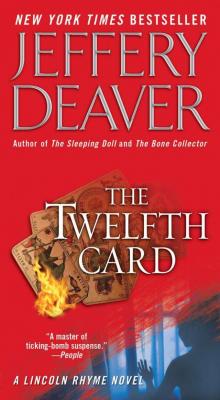 The Twelfth Card
The Twelfth Card The Bone Collector
The Bone Collector The Stone Monkey
The Stone Monkey The Sleeping Doll
The Sleeping Doll The Vanished Man
The Vanished Man The Kill Room
The Kill Room The Burial Hour
The Burial Hour An Acceptable Sacrifice
An Acceptable Sacrifice The Coffin Dancer
The Coffin Dancer The Lesson of Her Death
The Lesson of Her Death The Empty Chair
The Empty Chair The Burning Wire
The Burning Wire Watchlist
Watchlist Captivated
Captivated The Cold Moon
The Cold Moon Speaking in Tongues
Speaking in Tongues Buried (Hush collection)
Buried (Hush collection) A Textbook Case
A Textbook Case The Victims' Club
The Victims' Club Nothing Good Happens After Midnight: A Suspense Magazine Anthology
Nothing Good Happens After Midnight: A Suspense Magazine Anthology The Bodies Left Behind
The Bodies Left Behind Turning Point
Turning Point Hard News
Hard News The Blue Nowhere
The Blue Nowhere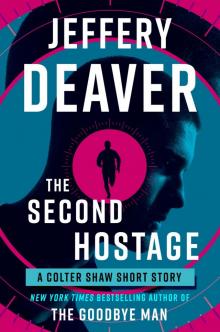 The Second Hostage
The Second Hostage The Never Game
The Never Game The Devil's Teardrop
The Devil's Teardrop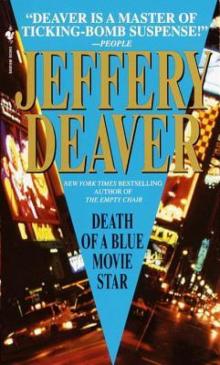 Death of a Blue Movie Star
Death of a Blue Movie Star The Skin Collector
The Skin Collector The Final Twist
The Final Twist Surprise Ending
Surprise Ending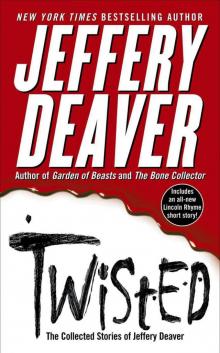 Twisted: The Collected Stories
Twisted: The Collected Stories Solitude Creek: Kathryn Dance Book 4
Solitude Creek: Kathryn Dance Book 4 Twisted: The Collected Short Stories of Jeffery Deaver
Twisted: The Collected Short Stories of Jeffery Deaver Rhymes With Prey
Rhymes With Prey Shallow Graves
Shallow Graves Bloody River Blues
Bloody River Blues Trouble in Mind: The Collected Stories, Volume 3
Trouble in Mind: The Collected Stories, Volume 3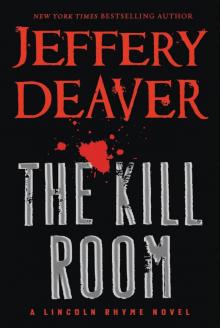 Lincoln Rhyme 10 - The Kill Room
Lincoln Rhyme 10 - The Kill Room The Cutting Edge
The Cutting Edge Where the Evidence Lies
Where the Evidence Lies Hell's Kitchen
Hell's Kitchen Twisted
Twisted The Goodbye Man
The Goodbye Man The burning wire lr-9
The burning wire lr-9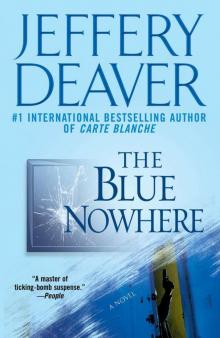 The Blue Nowhere: A Novel
The Blue Nowhere: A Novel Roadside Crosses: A Kathryn Dance Novel
Roadside Crosses: A Kathryn Dance Novel The Debriefing
The Debriefing More Twisted: Collected Stories, Vol. II
More Twisted: Collected Stories, Vol. II The Kill Room lr-10
The Kill Room lr-10 A Dish Served Cold
A Dish Served Cold Bloody River Blues: A Location Scout Mystery
Bloody River Blues: A Location Scout Mystery The Bodies Left Behind: A Novel
The Bodies Left Behind: A Novel Where the Evidence Lies (A Mulholland / Strand Magazine Short)
Where the Evidence Lies (A Mulholland / Strand Magazine Short) A Textbook Case (lincoln rhyme)
A Textbook Case (lincoln rhyme) Copycat
Copycat The Chopin Manuscript: A Serial Thriller
The Chopin Manuscript: A Serial Thriller Carte Blanche
Carte Blanche The Sequel
The Sequel